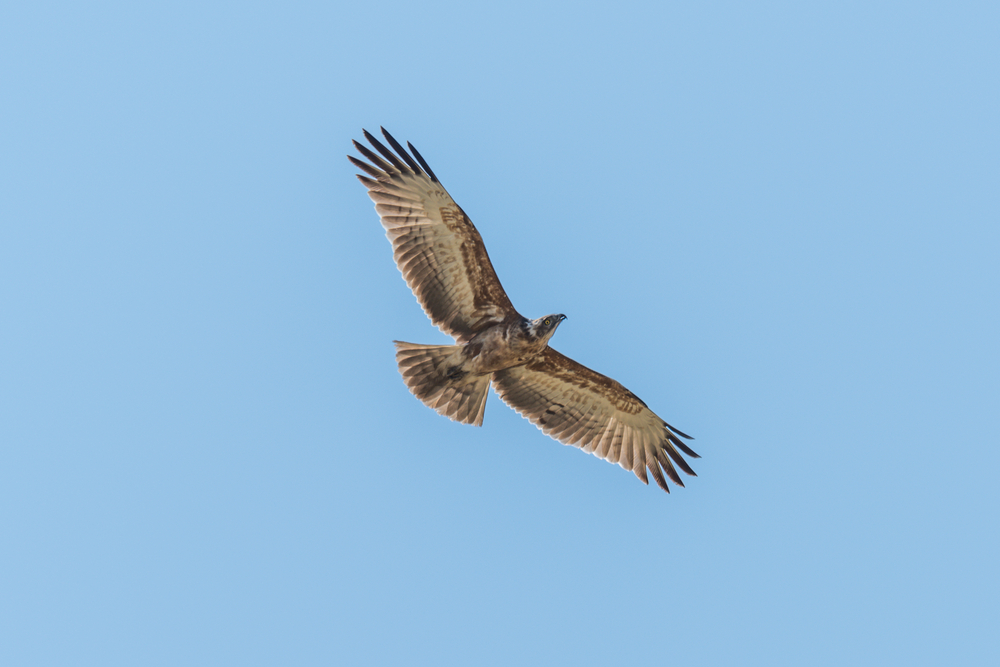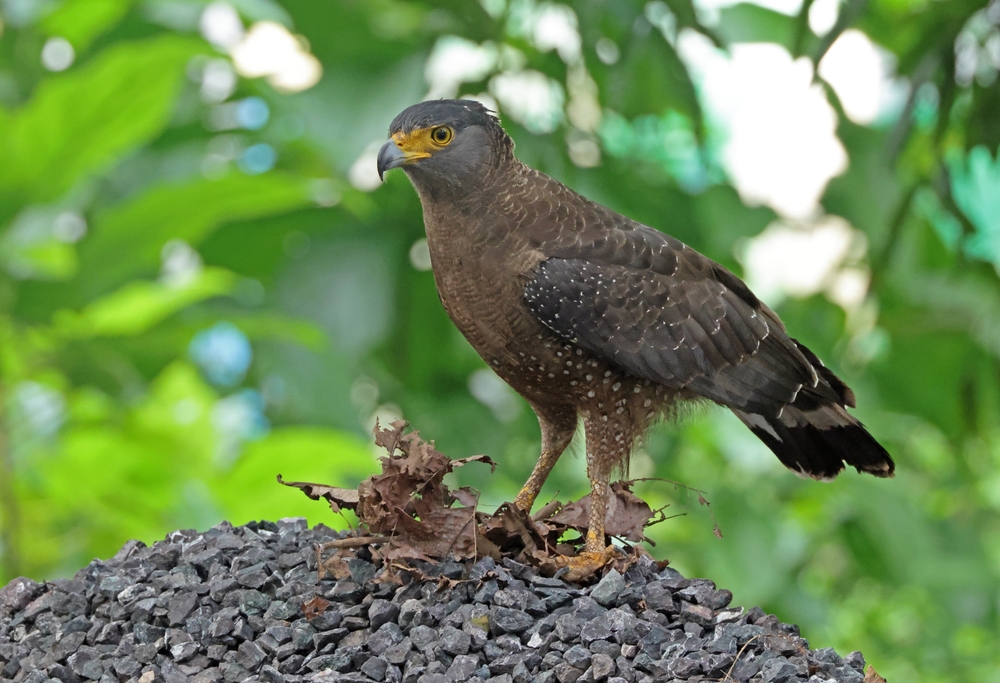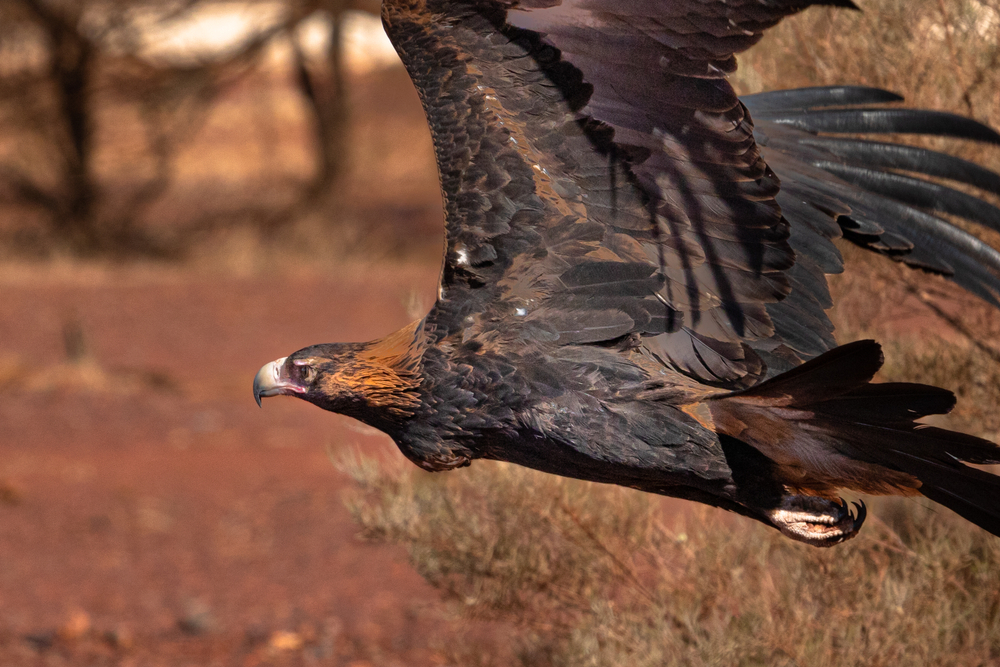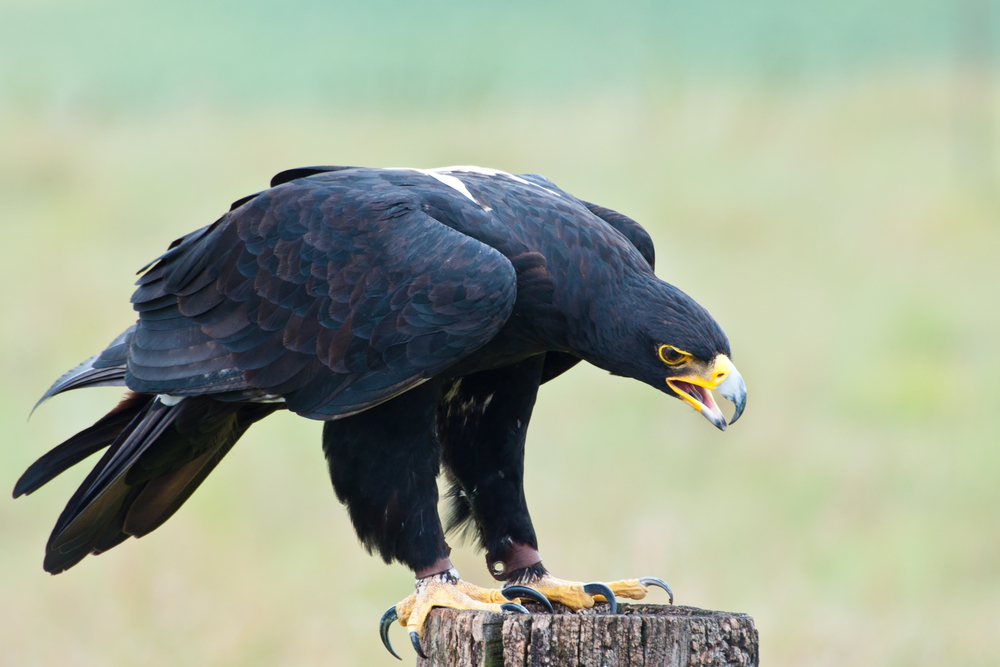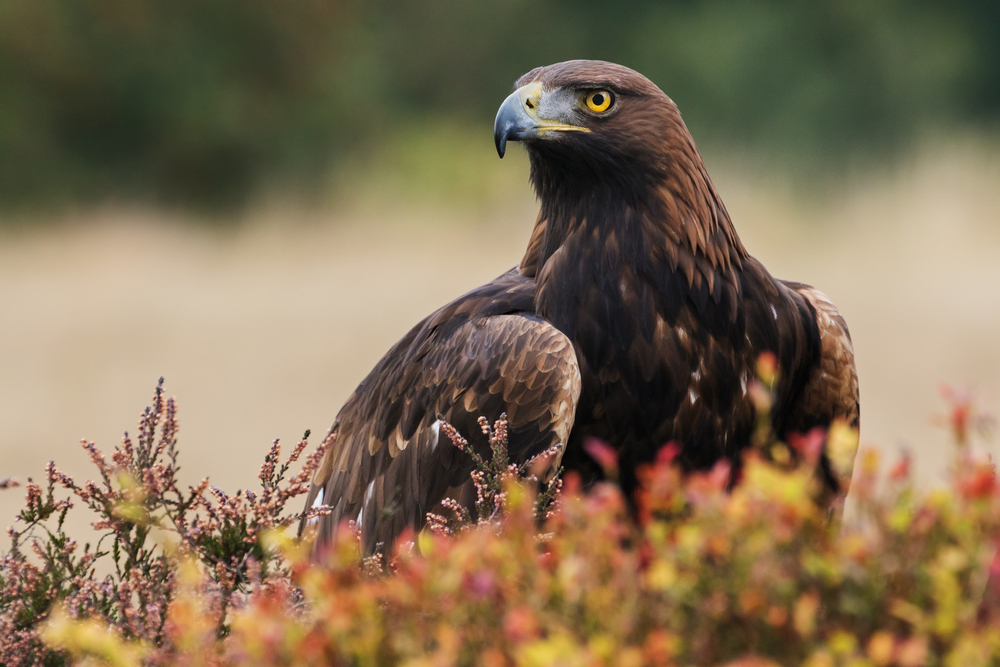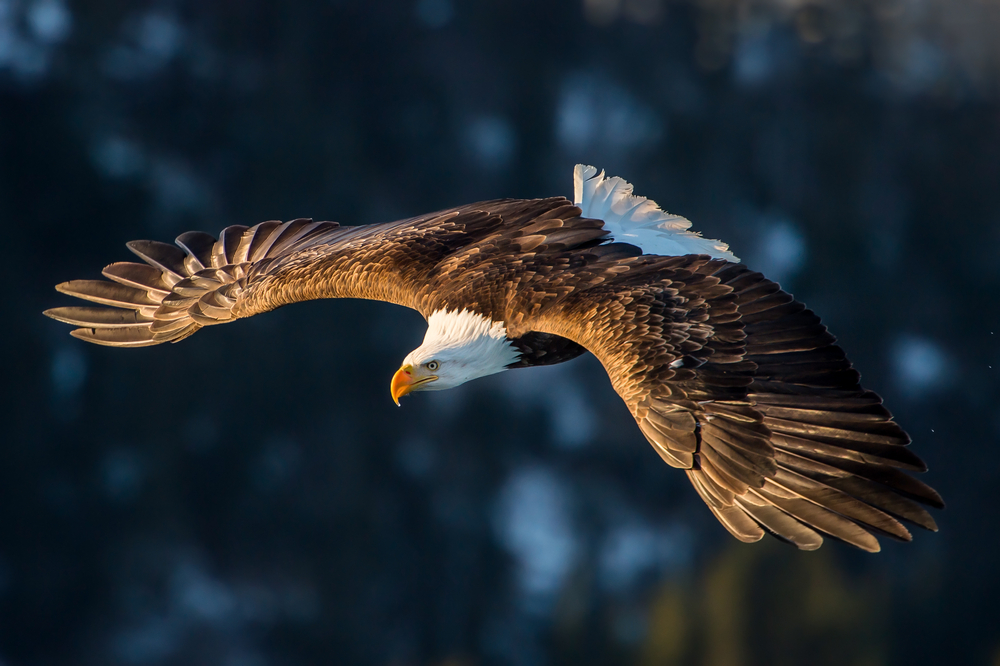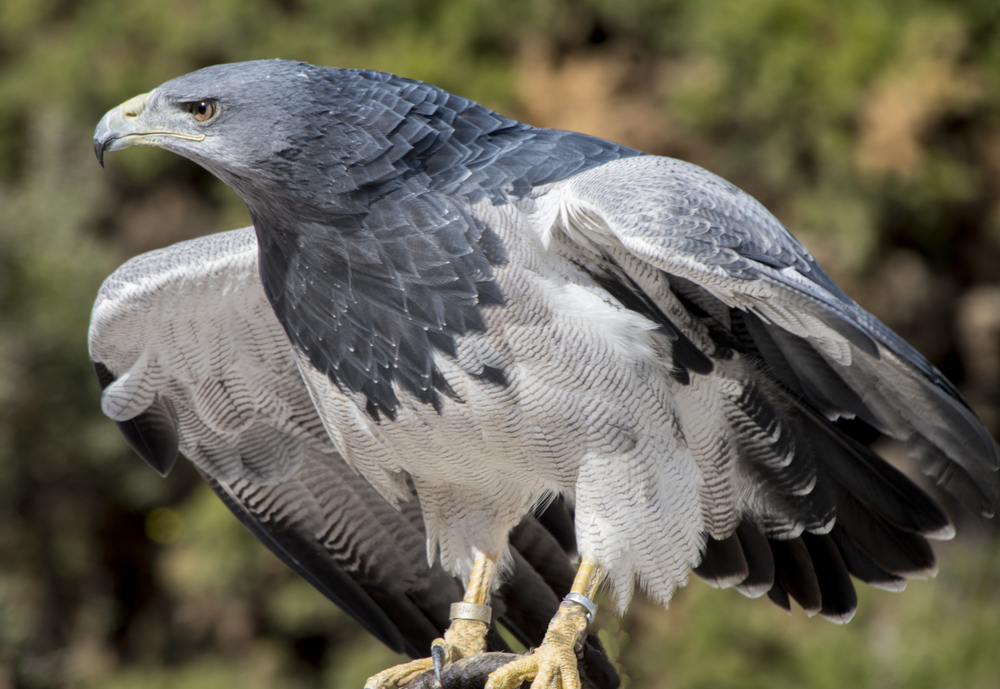The Crowned Eagle’s closest relatives are other large forest eagles within the subfamily Aquilinae, particularly the Harpy Eagle (Harpia harpyja) of South America and the Philippine Eagle (Pithecophaga jefferyi). All three share adaptations for hunting large prey in dense forests.
About
The Crowned Eagle is one of Africa’s most powerful and formidable raptors, renowned for its striking appearance and extraordinary hunting abilities. Found in sub-Saharan Africa’s forests, woodlands, and riverine habitats, this eagle is often called the “leopard of the air” for its strength and capacity to take down prey much larger than itself, including antelope and monkeys. Its dramatic plumage features bold brown and black markings, a barred tail, and a distinctive double crest that can be raised when the bird is alert or displaying.
Crowned Eagles are large raptors, measuring 80–99 cm (31–39 in) in length with a wingspan of 150–180 cm (5–6 ft). Despite having shorter, rounded wings compared to soaring eagles, they are built for agility, enabling them to weave swiftly through dense forest canopies. Their talons are immense and powerful, considered among the strongest of any eagle, capable of crushing bone and delivering fatal strikes.
Breeding usually takes place in tall forest trees, where pairs construct enormous stick nests, often reused for many years. The female typically lays one or two eggs, though usually only one chick is successfully raised, as the stronger nestling outcompetes the other. The young fledge after about 100–115 days but may remain dependent on their parents for nearly a year. In the wild, Crowned Eagles can live up to 14 years or more.
The scientific name of the Crowned Eagle is Stephanoaetus coronatus, and it belongs to the family Accipitridae, which includes other powerful eagles, hawks, and kites. Though widespread across sub-Saharan Africa, the species faces population pressures from deforestation, habitat loss, and conflict with humans due to predation on livestock. Nevertheless, it is admired as one of the most impressive and skillful hunters in the bird world, embodying the raw power of Africa’s forests.
Physical Characteristics
The Crowned Eagle (Stephanoaetus coronatus), often regarded as Africa’s most powerful eagle, is a large forest-dwelling raptor recognized for its bold plumage and formidable build.
Plumage:
Adults have dark brown upperparts with boldly barred black-and-white underparts. Their wings are broad and rounded, while the underwing coverts are pale with strong barring. The tail is long, gray, and marked with distinctive dark bands, aiding maneuverability in dense forests. Juveniles are paler overall, with creamy white heads and chests and less defined markings, gradually darkening with age.
Head and Face:
They have a large, crested head—hence the name “crowned”—with a prominent feathered crest that can be raised or flattened. Their eyes are a striking yellow, and their heavy, sharply hooked beak is built for tearing through thick hides and bones.
Body and Wings:
The Crowned Eagle has a stocky, muscular body, broad wings adapted for short bursts of power in forests rather than long-distance soaring. The long tail provides balance and agility, allowing them to navigate dense canopy cover.
Size:
-
Length (Body): 31 to 39 in (80 to 99 cm)
-
Wingspan: 59 to 71 in (150 to 180 cm)
-
Tail Length: 15 to 17 in (38 to 43 cm)
Weight:
-
Males: 6.6 to 8.8 lbs (3 to 4 kg)
-
Females: 8.8 to 10 lbs (4 to 4.7 kg), making them among the heaviest African eagles.
The Crowned Eagle’s imposing crest, bold barring, and muscular build make it one of Africa’s most striking and powerful raptors, perfectly adapted for ambush hunting in forest habitats.
Reproduction
The Crowned Eagle has a slow reproductive cycle, with pairs investing heavily in raising a single chick, a strategy typical of large, long-lived raptors.
1. Mating and Courtship:
Crowned Eagles are monogamous and form lifelong pair bonds. Courtship displays include dramatic aerial dives, spirals, and loud duetting calls that echo through the forest canopy.
2. Nesting:
Nests are enormous structures, built high in large forest trees, often exceeding 5 to 6 feet (1.5 to 1.8 m) in diameter and reused for many years. They are made of large sticks and lined with fresh green leaves.
3. Egg-Laying:
The female usually lays a single egg, rarely two, every 2 to 3 years. Eggs are whitish with faint blotches.
4. Incubation:
Incubation lasts 49 to 51 days, carried out mainly by the female while the male provides food.
5. Raising Chicks:
The chick hatches covered in white down and is brooded closely for several weeks. The female remains near the nest, while the male hunts and delivers prey such as monkeys, duikers, and other medium-sized mammals.
6. Fledging and Independence:
Young fledge at around 90 to 110 days but remain dependent on their parents for food for another 9 to 12 months. This long dependency means pairs breed only once every two years.
The Crowned Eagle’s reproductive cycle is characterized by low clutch size, lengthy incubation, and extended parental care, ensuring high survival rates for its single chick in challenging forest environments.
Lifespan
The Crowned Eagle is a long-lived forest raptor, with survival tied to stable territories, prey availability, and forest protection.
Lifespan in the Wild:
In natural conditions, Crowned Eagles typically live 14 to 20 years, though some individuals may reach 25 years. Juvenile mortality is high, as young eagles face difficulties learning to hunt large, dangerous prey such as monkeys and small antelope. Adults that secure strong forest territories generally live the longest.
Lifespan in Captivity:
In zoos and conservation centers, Crowned Eagles can live 30 to 35 years with consistent veterinary care, secure housing, and reliable access to food.
Threats to the Crowned Eagle:
-
Habitat Loss: Deforestation and forest fragmentation reduce available hunting grounds and nesting trees.
-
Human Conflict: In some regions, they are persecuted for preying on livestock or small domestic animals.
-
Food Decline: Reductions in monkey and antelope populations impact breeding success.
-
Electrocution & Collisions: Power lines and expanding infrastructure pose growing risks.
-
Slow Reproduction: Low breeding frequency (1 chick every 2–3 years) makes populations vulnerable to losses.
Care and Protection:
Conservation efforts focus on forest preservation, education, and reducing persecution. Protecting prey populations and large nesting trees is essential for their survival.
The Crowned Eagle’s long lifespan and very slow reproductive cycle highlight both its power as Africa’s top forest predator and its vulnerability to human pressures.
Eating Habits
The Crowned Eagle is Africa’s most powerful forest eagle, renowned for its ability to hunt prey much larger than itself.
Diet:
Their diet consists mainly of medium-sized mammals, especially primates (monkeys such as vervets and colobus) and small antelopes like duikers. They also hunt hyraxes, large birds, and occasionally monitor lizards. This reliance on mammals sets them apart from many other eagle species.
Hunting Strategy:
Crowned Eagles are stealth hunters, relying on ambush from the forest canopy. They perch quietly, scanning for movement below, then swoop down with explosive speed and accuracy.
Killing Technique:
They use their immensely powerful talons to crush the skulls or spines of prey, killing almost instantly. Their legs and feet are considered among the strongest of any eagle, relative to size.
Feeding Behavior:
Once prey is subdued, it is carried to a perch or nest. Large kills may be consumed over several days, with eagles often covering leftovers with foliage to conceal them from scavengers.
Special Considerations:
-
Powerful Grip: Their talons are capable of exerting tremendous force, allowing them to kill prey larger than themselves.
-
Prey Specialization: Their dependence on primates and small antelopes makes them highly specialized, but also vulnerable to declines in these populations.
-
Role in Ecosystem: As apex predators, they regulate populations of monkeys and small ungulates in African forests.
The Crowned Eagle’s specialized diet, crushing talons, and ambush tactics make it one of the most formidable avian predators in the world.
Uniqueness
The Crowned Eagle is one of Africa’s most powerful and distinctive raptors, revered for its strength, forest-hunting skills, and dramatic appearance.
Powerful Hunter:
Relative to body size, the Crowned Eagle is considered the strongest eagle in the world, capable of killing prey much heavier than itself, including monkeys and small antelopes.
Striking Appearance:
Its bold black-and-white underparts, barred tail, and large erect crest give it a regal look, while its piercing yellow eyes add to its fierce expression.
Specialized Forest Predator:
Unlike many open-country eagles, the Crowned Eagle is adapted to dense forest habitats, using its long tail and broad wings for agile maneuvering through thick canopy.
Cultural Significance:
In several African traditions, the Crowned Eagle symbolizes strength, royalty, and spiritual power. Its haunting calls echoing through the forest canopy have made it a figure in folklore and myth.
Slow Reproduction:
Its reproductive strategy—raising only one chick every 2 to 3 years—makes it unique among eagles, but also vulnerable to habitat loss and persecution.
The Crowned Eagle’s combination of immense strength, forest specialization, and cultural reverence makes it one of the most unique and awe-inspiring raptors in the world.
Be the First to Share Photos of This Species.
FAQ’s
1. What is the closest species to the Crowned Eagle?
2. How does the Crowned Eagle compare to other eagles?
The Crowned Eagle is considered the most powerful eagle in Africa relative to its size, with talons strong enough to kill monkeys and small antelopes. Unlike open-country eagles such as the Martial Eagle or Golden Eagle, it is specialized for dense forest hunting, with a long tail for maneuverability and ambush tactics. Its bold crest and black-and-white barring also make it visually unique.
3. What national parks provide the best chance to see a Crowned Eagle?
Crowned Eagles inhabit African forests from West to East and southern Africa. Some of the best national parks to spot them include Kruger National Park (South Africa), Udzungwa Mountains National Park (Tanzania), Kibale National Park (Uganda), and Kakum National Park (Ghana), where they hunt in forest canopies.



































































